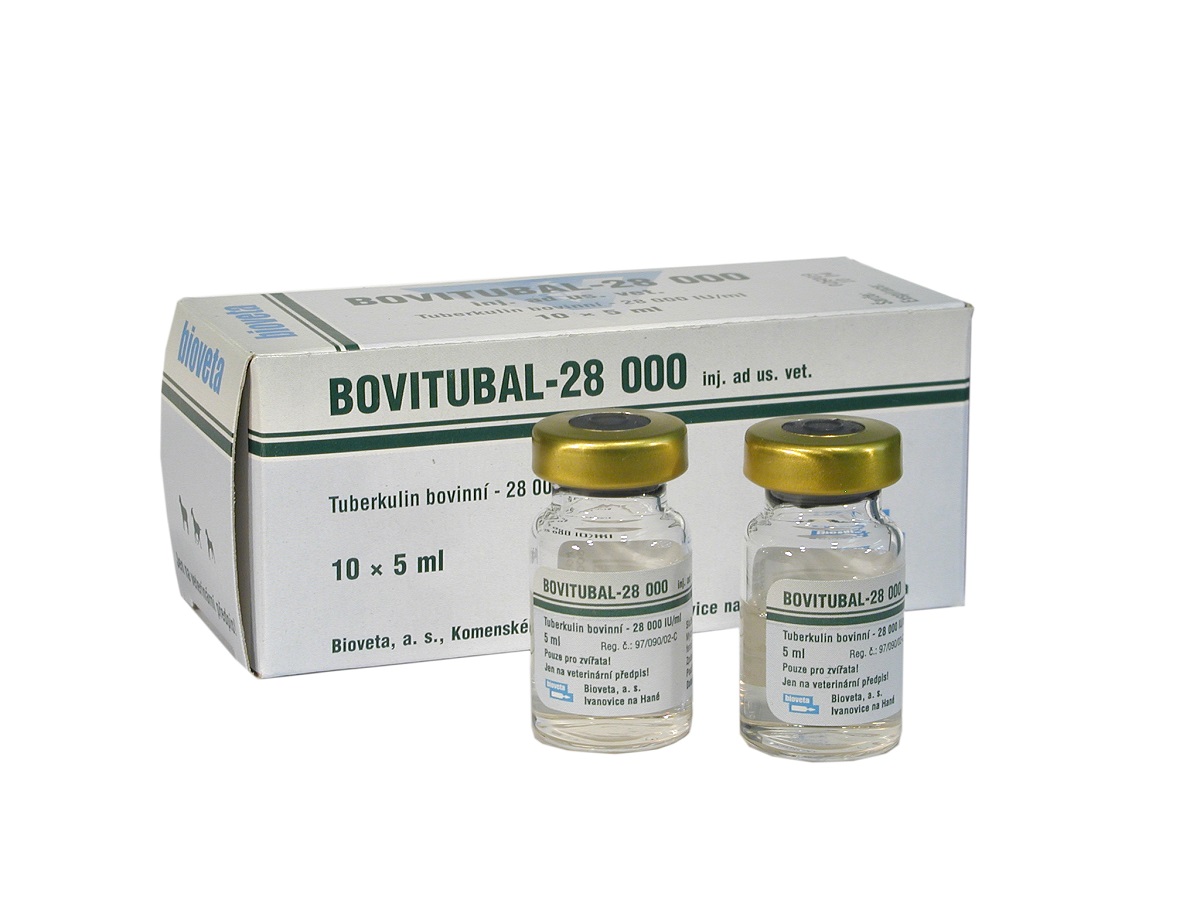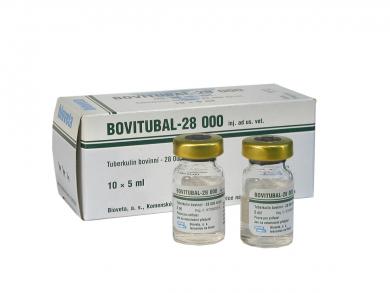BOVITUBAL 28 000 inj. ad us. vet.
Homepage Products Veterinary products BOVITUBAL 28 000 inj. ad us. vet.
For simple tuberculization of cattle and comparative tuberculization of other species of animals.
| type of preparative: | Diagnostics |
|---|---|
| target species animals: | Goat, Horse, Cattle, Dog, Pig, Sheep |
Pharmaceutical form
Injection.
Composition
Proteinum tuberculini Mycobacterii bovis (strain AN 5) - 28 000 IU.
Indication
For simple tuberculization of cattle and comparative tuberculization of other species of animals.
Target animals
Cattle, sheep, goats, pigs, horses, dogs.
Dosage and application
Simple tuberculization – apply 0.1 ml dose regardless of the animal species.
Cattle tuberculization:
The place of application is situated at the border of the anterior and middle thirds of the neck. The skin must be without pathological changes, equally thick with the possibility of an easy cutaneous drape formation. The place of tuberculin administration is perfectly cut and cleaned. The cutaneous drape is formed with the thumb and the point finger and its thickness is after cutimetre measuring recorded. The dosage of 0.1 ml of tuberculin is applicated by means of a short sterile needle, bevel edge outwards, with graduated syringe charged with tuberculin, inserted obliquely into the deepest layers of the skin. The right reaction after intradermal administration - the papula formation in the place of allergen inoculation - must be detected by palpation. If the tuberculin was not administered intradermally, it is possible to repeat the administration in the same place in the prescribed dosage. If the skin is injured during cutting or if skin changes are determined before tuberculin administration, it is necessary to inoculate tuberculin on another place of the same neck side. The origin place is canceled with the haircut.
Evaluation: The reaction is evaluated in 72 (± 4) hours after tuberculin administration by adspection, skin palpation eventually by measuring of the cutaneous drape strengthening with the cutimetre. Animals without any changes detectable by adspection or palpation in the place of tuberculin inoculation are considered to be negative. In cases, where there were revealed by adspection or palpation skin swellings, the swelling thickness (reaction number) is determined from the difference between the basic skin thickness before inoculation and on evaluation.
-
Negative reaction: If there is apparent only bordered swelling with the cutaneous drape strengthening of max. 2 mm without clinical symptoms as diffusion or large swelling, exudation, necrosis, painfulness or inflammation reaction of the corresponding lymphatic vessels or lymphatic nodes.
-
Dubious reaction: If there is apparent no clinical symptom stated in item a) but the cutaneous drape strengthening is higher than 2 mm but lower than 4 mm.
-
Positive reaction: If there are apparent clinical symptoms stated in item a) or the cutaneous drape in the place of application is thicker by 4 mm or more.
Sheep tuberculization:
Tuberculization is carried out after wool cutting on the dorsal side of the pinna.
Evaluation: The reaction is evaluated in 48 - 72 hours after tuberculin administration. In the positive reaction there are inflammation changes apparent in the place of tuberculin inoculation; e.g. swelling eventually redness, painfulness and skin temperature rising.
Goats tuberculization:
Tuberculization is carried out on the neck similarly to cattle.
Evaluation: The reaction is evaluated in 48 - 72 hours after tuberculin administration. In the positive reaction there are inflammation changes apparent in the place of tuberculin inoculation; e.g. swelling eventually redness, painfulness and skin temperature rising.
Pigs tuberculization:
Tuberculization is carried out on the dorsal side of the pinna. The place of administration is in the skin bend on the transition from the head to the dorsal ear part, eventually 2 - 3 cm from the base of the pinna.
Evaluation: The reaction is evaluated in 48 hours after tuberculin administration. The reaction is considered to be positive, if there is the characteristic inflammative swelling in the place of injection which is often accompanied with erythema and sometimes even with the central necrosis. Skin swelling with possible necrosis is the main symptom of inflammative reaction in pigmentated pigs. In tuberculosis free breedings the positive reaction is represented by the swelling of more than 20 mm in diametre and 10 - 20 mm swelling is considered to be dubious reaction. In breedings, where tuberculosis was proved, the reaction is positive if the inflammative changes diametre is more than 10 mm and if it is less than 10 mm, the reaction is classified as dubious.
Horses tuberculization:
Tuberculin is administered on the neck.
Evaluation: The reaction is evaluated in 72 hours after tuberculin administration. Only negative result, e.g. where there is no inflammative reaction in the place of administration, has the diagnostic importance.
Dogs tuberculization:
Tuberculin is administered after hair cutting on the dorsal side of the pinna.
Evaluation: The reaction is evaluated in 24 - 48 hours. Only negative result, e.g. where there is no inflammative reaction in the place of administration, has the diagnostic importance.
Storage
Store in a refrigerator (2°C -8 °C). Protect from light. Store in a dry place.
Withdrawal period
Zero days.
Shelf life
2 years.
Shelf life after the first opening: 10 hours.
Package
1 x 1 ml, 5 x 1 ml, 10 x 1 ml, 1 x 2 ml, 5 x 2 ml, 10 x 2 ml, 1 x 5 ml, 5 x 5 ml, 10 x 5 ml, 1 x 10 ml, 5 x 10 ml, 10 x 10 ml, 1 x 20 ml, 5 x 20 ml, 10 x 20 ml.
Not all pack sizes may be marketed.










